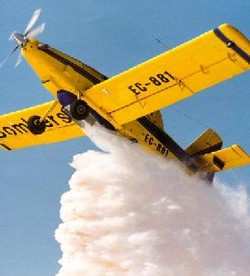Gives Pilots An Increased Safety Margin At Night
Fighting fires at night is an effective tool for combating threatening wildfires. Temperatures drop, humidity typically increases and it is easier to spot hot spots at night making nighttime firefighting ideal. Now, CO Fire Aviation has a new tool to combat fires at night. Aviation Specialties Unlimited, Inc., (ASU) recently modified an Air Tractor AT-802F for night vision goggle (NVG) operations giving pilots an increased advantage in the safety and effectiveness at night.

“We have experienced our share of fires in Idaho that consumed and destroyed vital natural resources, forests, homes and beautiful parts of the mountainous and high desert landscape,” said ASU Vice President of Engineering Kip McDermott. “By modifying the Air Tractor for CO Fire, we have provided them with a key safety tool that will allow them to safely battle fires into the night.”
Since 1995 ASU has modified more than 1,300 aircraft for NVG operations including the Thrush S-2R, PZL-Mielec M18, and rotorcraft including the Bell 206 and OH-58A for aerial application operations but the AT-802 is the first fixed-wing dedicated to firefighting. Because of its 800 gallon capacity, maneuverability, and speed with a 1,600 horsepower engine the AT-802 is ideal for fighting fires in a variety of terrains and conditions.
CO Fire Aviation, starting with just one aircraft in 2015, has grown dramatically to eight aircraft and fourteen pilots to meet the growing demand for agile aerial firefighting capabilities. They are currently performing daytime contracts with a number of state and federal agencies and now their experienced team can offer the capability of night time aerial firefighting to customers domestically and abroad.
“Having operated NVGs in a variety of operations, our pilots knew that implementing a comprehensive NVG program would be the most significant way we could improve the safety and effectiveness of our aerial firefighting operations,” said CO Fire Chief Pilot Chris Doyle. “ASU’s experienced team has a strong track record with aerial applicators and we trusted them to equip our aircraft and help us launch our NVG program.”
Half of the CO Fire pilots are currently NVG certified including two FAA-approve NVG Instructor Pilots that will be establishing an in-house NVG training program.
“Our pilot cadre has a wealth of extensive NVG experience,” said Doyle. He explained that several of the pilots have military experience providing close air support during combat and employing weapons delivery with the A-10 Thunderbolt “Warthog” aircraft and were U.S. Air Force Fighter Weapons School Instructors. Doyle has more than 26 years of flight experience and more than 10,000 accident-free hours of flight. He is a factory certified Air Tractor 802 instructor, he was also a Maintenance test pilot for the military/weaponized version of the AT-802 in the Middle East along with a number of his current Pilot cadre whom were the weapons and tactics instructors. “There is currently no other company in the world with more AT-802 NVG experience than CO Fire Aviation,” said Doyle.
“Later this year CO Fire will be conducting studies to refine and develop NVG firefighting tactics,” said Doyle. The study will involve developing safe and effective drop heights across a variety of illumination levels and in different terrain for example dealing with well moonlit and starlit nights through to low-light scenarios and setting requisite minimums to lux (illumination) levels vs. terrain vs. drop height. “We are always looking for innovations to help us lead the way in safety.”
(Source: Aviation Specialties Unlimited news release. Image from file)
 ANN's Daily Aero-Term (04.28.24): Airport Marking Aids
ANN's Daily Aero-Term (04.28.24): Airport Marking Aids Aero-News: Quote of the Day (04.28.24)
Aero-News: Quote of the Day (04.28.24) ANN's Daily Aero-Linx (04.28.24)
ANN's Daily Aero-Linx (04.28.24) Aero-News: Quote of the Day (04.29.24)
Aero-News: Quote of the Day (04.29.24) ANN's Daily Aero-Linx (04.29.24)
ANN's Daily Aero-Linx (04.29.24)



